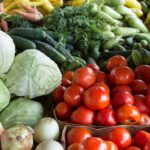
The Role of Cash Crops and Food Crops To Economic Development

Introduction to the role of cash crops and food crops in economic development. Unveiling the Role of Cash Crop and Food Crops in Development Agriculture has always been a critical sector of the global economy, and it continues to play a significant role in the economic development of many countries today. However, the debate over the economic impact of cash crop and food crops on development has been ongoing for decades. Some argue that cash crop can bring in substantial revenue and boost economic growth, while others contend that food crops are more important for sustenance and reducing poverty.
In this article, we delve into the different aspects of the economic impact of both cash and food crops on development, and the role they play in improving the livelihoods of farmers, enhancing food security, reducing poverty, and boosting overall economic growth. We will also explore the challenges associated with the cultivation of cash crop and food crops, and discuss some of the strategies that can be implemented to harness their full potential in driving economic development.
Cash crops and food crops play a crucial role in economic development, particularly in agricultural-based economies. These crops not only contribute to food security but also have a significant impact on the overall economic growth of a nation. In this section, we will delve into the importance of cash crop and food crops and how they contribute to the development of nations.
Cash crop are agricultural crops that are grown primarily for sale, aiming to generate income for farmers and the country as a whole. These crops include commodities such as coffee, cocoa, cotton, tea, tobacco, and rubber, among others. The cultivation and export of cash crop have a direct impact on a nation’s balance of trade, as they generate foreign exchange earnings. This, in turn, strengthens the country’s economy and contributes to its overall development. Furthermore, the production of cash crop often requires advanced farming techniques and technology, leading to increased productivity and efficiency in the agricultural sector.
On the other hand, food crops are essential for ensuring food security and meeting the nutritional needs of a nation’s population. These crops include staples such as rice, wheat, maize, and potatoes, as well as a variety of fruits and vegetables. The cultivation of food crops not only provides sustenance for the population but also creates employment opportunities within the agricultural sector. Moreover, a robust food crop production system helps reduce dependence on imports, stabilizes food prices, and strengthens the nation’s food sovereignty.
The economic impact of cash crops and food crops goes beyond their direct contributions to trade and food security. Their production and marketing often involve various value chains, creating additional employment opportunities in areas such as transportation, processing, packaging, and marketing. This stimulates rural development and reduces unemployment rates, ultimately contributing to poverty alleviation and improved standards of living.
However, it is important to strike a balance between cash crop and food crops to ensure sustainable development. Overreliance on cash crop may lead to neglecting food crop production, potentially compromising food security and increasing vulnerability to external market fluctuations. Therefore, a comprehensive approach that considers both economic gain and food sustainability is crucial for long-term development.
In the following sections, we will explore the specific economic benefits of cash crop and food crops, including their contribution to export earnings, employment generation, rural development, and poverty reduction. By understanding the multifaceted role of these crops, we can better appreciate their significance in driving economic growth and creating a more prosperous future for nations reliant on agriculture.
Understanding the difference between cash crops and food crops
In the realm of agriculture, it is crucial to understand the distinction between cash crop and food crops. Both types play a significant role in the economic development of a region, but their purposes and characteristics differ.
Food crops, as the name suggests, are cultivated primarily for consumption. These crops serve as a vital source of sustenance for local communities and contribute to food security. Staple crops like rice, wheat, maize, and potatoes fall under this category. They form the foundation of diets worldwide and are essential for meeting basic nutritional needs.
On the other hand, cash crop are cultivated with the intention of generating profit. These crops are grown for commercial purposes and are usually traded on the global market. Examples of cash crops include coffee, cocoa, tea, cotton, and tobacco. The demand for these crops, both domestically and internationally, drives their cultivation. Cash crop often require specific climatic conditions, fertile soils, and skilled labor, leading to concentrated production in specific regions.
Understanding the difference between cash crop and food crops is crucial for policymakers, farmers, and investors. Cash crop can bring substantial economic benefits to a region by providing employment opportunities, generating foreign exchange through exports, and stimulating overall economic growth. However, relying heavily on cash crop can also pose risks, as fluctuations in global market prices and demand can impact the livelihoods of farmers and the stability of local economies.
Food crops, on the other hand, play a pivotal role in ensuring food security and promoting self-sufficiency. By focusing on the cultivation of food crops, countries can reduce their reliance on imports, strengthen local agriculture, and provide a stable food supply for their populations. Additionally, investing in the development of food crop production can enhance rural livelihoods, reduce poverty, and foster sustainable agricultural practices.
Balancing the cultivation of both cash crops and food crops is essential for achieving sustainable development. Governments and agricultural stakeholders must consider the socio-economic and environmental implications of their agricultural strategies. By prioritizing both food security and economic growth, countries can harness the potential of cash crops and food crops to drive inclusive and sustainable development.
The historical significance and global trade of cash crops
Cash crop have played a significant role in shaping the course of history and have had a profound impact on global trade. These crops, primarily grown for their commercial value, have been instrumental in driving economic development and transforming societies across the world.
The historical significance of cash crop can be traced back to the era of European colonialism. During this time, powerful nations sought to expand their empires and exploit the resources of newly discovered lands. Cash crop, such as sugar, tobacco, coffee, and cotton, became highly sought-after commodities due to their profitability and market demand.
The cultivation of cash crop led to the establishment of plantations in various regions, particularly in colonies located in tropical and subtropical climates. These plantations, often worked by enslaved or indentured labor, became centers of concentrated agricultural production. The profits generated from cash crops played a crucial role in the economic growth of colonial powers, fueling industrialization and financing infrastructure development.
The global trade of cash crop shaped the dynamics of international commerce. European colonial powers established extensive trade networks that connected distant regions of the world. The Transatlantic Slave Trade, for instance, was intimately linked to the cultivation and trade of cash crop, as millions of enslaved individuals were forcibly transported to the Americas to work on plantations.
The demand for cash crop also spurred the rise of mercantilism, a system in which colonies were seen as sources of raw materials to be exported to the mother country. This unequal trade relationship entrenched global economic disparities, with colonies serving as suppliers of cash crop and importing manufactured goods from their colonizers.
Even in the post-colonial era, cash crop continue to play a vital role in the global economy. Many developing countries heavily rely on the production and export of cash crop as a means of generating foreign exchange earnings and stimulating economic growth. Cash crop can provide opportunities for small-scale farmers to participate in global markets and improve their livelihoods.
However, the reliance on cash crop also poses challenges. Fluctuations in global market prices, climate change, and vulnerability to pests and diseases can jeopardize the livelihoods of farmers and negatively impact the economies of cash crop-dependent nations. Diversification of agricultural production and investment in sustainable farming practices are essential to mitigate these risks and ensure long-term economic stability.
The historical significance and global trade of cash crop have had a profound impact on economic development. From the era of colonialism to the present day, cash crop have shaped societies, spurred international trade, and provided livelihood opportunities. Understanding the role of cash crop in development is crucial for policymakers and stakeholders to navigate the complexities of agricultural systems and promote sustainable economic growth.

The economic benefits and challenges of cash crop cultivation
Cash crop cultivation plays a significant role in the economic development of many countries around the world. These crops, which are primarily grown for commercial purposes rather than personal consumption, contribute to foreign exchange earnings and job creation. The economic benefits associated with cash crop cultivation are undeniable, but they also come with their fair share of challenges.
One of the primary advantages of cultivating cash crops is the potential for high profits. These crops often have a higher market value compared to food crops, allowing farmers to generate substantial income. Additionally, cash crops are typically in high demand both domestically and internationally, ensuring a steady market for farmers. This not only benefits individual farmers but also contributes to the overall economic growth of the country.
Cash crop cultivation also has the potential to create employment opportunities. Large-scale cultivation requires a significant labor force, which helps reduce unemployment rates and improves livelihoods. Moreover, cash crop production often involves various stages, such as planting, harvesting, processing, and packaging, leading to job creation in multiple sectors of the economy. This, in turn, stimulates economic activity and enhances the standard of living for individuals involved in the cash crop value chain.
However, along with these economic benefits, cash crop cultivation presents its own set of challenges. One of the main concerns is the risk of overreliance on a single crop. Dependency on cash crop can make economies vulnerable to fluctuations in global market prices, weather conditions, and pests or diseases. If the market experiences a downturn or if a crop fails due to unfavorable weather conditions or infestations, farmers and the economy as a whole may suffer significant losses.
Another challenge associated with cash crop cultivation is the potential negative impact on food security. When farmers prioritize cash crop, they may allocate less land and resources to the cultivation of food crops, leading to a decrease in local food production. This can result in increased reliance on food imports, which may be subject to price volatility and supply disruptions. Balancing the cultivation of cash crop with food crops is crucial to ensure both economic prosperity and food security.
Cash crop cultivation brings undeniable economic benefits to countries, including increased foreign exchange earnings, job creation, and economic growth. However, it is essential to address the challenges that come with cash crop cultivation, such as market volatility and potential impacts on food security. Striking a balance between cash crop cultivation and food crop production is vital for sustainable economic development and the well-being of communities.
The impact of cash crops on local communities and small-scale farmers
Cash crops play a significant role in the economic development of local communities and small-scale farmers. These crops, which are primarily grown for commercial purposes and export, have the potential to generate substantial income and improve the livelihoods of farmers.
One of the key advantages of cash crops is their ability to create employment opportunities in rural areas. The cultivation, harvesting, processing, and transportation of these crops require a significant labor force, which directly contributes to job creation. This, in turn, helps alleviate poverty and reduces rural-urban migration as individuals can find employment opportunities within their local communities.
Moreover, cash crop can provide a stable source of income for small-scale farmers. By diversifying their agricultural activities and cultivating high-value cash crop, farmers can increase their earnings and enhance their economic resilience. This additional income can be used to invest in education, healthcare, improved farming techniques, and other essential needs, thus contributing to long-term development.
Cash crop also have the potential to stimulate local economies through increased trade and investment. When farmers engage in cash crop production, they become part of a larger value chain that involves processors, traders, exporters, and other intermediaries. This creates business opportunities and attracts investments in infrastructure, storage facilities, transportation networks, and processing plants, all of which contribute to the growth of local economies.
However, it is important to strike a balance between cash crop production and food crop cultivation to ensure food security for local communities. Overreliance on cash crop can lead to the neglect of food production, leaving communities vulnerable to food shortages and price fluctuations. Therefore, it is crucial to promote sustainable farming practices that integrate both cash crop and food crops, ensuring a stable and diverse agricultural system.
The impact of cash crop on local communities and small-scale farmers is undeniable. They have the potential to create employment, increase income, stimulate local economies, and contribute to overall development. However, it is crucial to adopt a balanced approach that prioritizes food security and sustainability to ensure the long-term well-being of communities relying on cash crop cultivation.
The importance of food crops for food security and sustainable development
Food crops play a crucial role in ensuring food security and promoting sustainable development in communities worldwide. These crops are the foundation of our food systems, providing essential nutrients and sustenance for billions of people.
One of the primary benefits of food crops is their contribution to food security. By cultivating diverse food crops, communities can ensure a stable and reliable food supply, reducing the risk of hunger and malnutrition. Food crops such as grains, vegetables, fruits, and legumes form the backbone of balanced diets, supplying essential vitamins, minerals, and dietary fiber that support overall health and well-being.
Moreover, the cultivation of food crops has a direct impact on local economies. Farmers engaged in food crop production not only meet the nutritional needs of their communities but also generate income through the sale of surplus produce. This income enables them to invest in education, healthcare, and other essential services, contributing to poverty reduction and improved living standards.
In addition to addressing immediate hunger concerns, food crops also have long-term sustainability implications. Sustainable farming practices, such as organic farming and agroforestry, can be applied to food crop production, minimizing the use of chemical inputs, preserving soil health, and promoting biodiversity. By adopting these practices, communities can enhance the resilience of their agricultural systems, mitigate the effects of climate change, and protect natural resources for future generations.
Furthermore, the importance of food crops extends beyond local communities. In many regions, food crops are vital for export, generating foreign exchange earnings and stimulating economic growth. Countries with successful food crop industries can leverage their agricultural resources to participate in global trade, fostering economic development and reducing dependency on external food sources.
Overall, food crops are integral to achieving food security, promoting sustainable development, and driving economic growth. By recognizing their significance and supporting their cultivation, communities and policymakers can pave the way for a more resilient, equitable, and prosperous future.
The role of food crops in providing employment and income opportunities
Food crops play a crucial role in providing employment and income opportunities, especially in developing countries where agriculture is a primary sector of the economy. These crops not only fulfill the basic need of food security but also contribute significantly to poverty reduction and rural development.
One of the key advantages of food crops is their labor-intensive nature. Cultivating and harvesting food crops require a substantial workforce, creating employment opportunities for the local population. Farmers, farm laborers, and various stakeholders in the agricultural value chain, such as processors, distributors, and retailers, all contribute to the overall economic growth and stability.
Moreover, food crops provide a source of income for farmers and their families. By selling their produce in local markets or to larger buyers, farmers can generate revenue to meet their household expenses and invest in the education and healthcare of their children. This income also enables them to reinvest in their farms, improving agricultural practices, and increasing productivity over time.
Additionally, food crops can stimulate rural development by fostering economic activities in the surrounding communities. Local markets, transportation networks, storage facilities, and other infrastructure necessary for the agricultural supply chain create ancillary jobs and business opportunities. This multiplier effect leads to the development of rural economies, enhancing overall living standards and reducing migration to urban areas.
Furthermore, food crop cultivation encourages entrepreneurship and innovation. Farmers often diversify their crops and adopt new technologies to maximize yields and optimize productivity. This entrepreneurial spirit fosters creativity and resilience in the agricultural sector, contributing to its long-term sustainability and competitiveness.
In summary, food crops play a vital role in providing employment and income opportunities, particularly in developing economies heavily dependent on agriculture. By creating jobs, generating income, and fostering rural development, food crops contribute to poverty alleviation and economic growth, ultimately leading to a more sustainable and prosperous society.
The potential risks and vulnerabilities of relying heavily on cash crops or food crops
While cash crop and food crops play a significant role in economic development, it is crucial to acknowledge the potential risks and vulnerabilities associated with relying heavily on them. One of the main risks is economic volatility. The prices of cash crop and food crops are often subject to fluctuations in global markets, which can have a ripple effect on the economies of countries heavily dependent on these crops. Sudden price drops can lead to financial instability, affecting the income and livelihoods of farmers and agricultural workers.
Furthermore, relying heavily on cash crop or food crops can lead to a lack of diversification in the agricultural sector. This monoculture approach increases the vulnerability of crops to pests, diseases, and other environmental factors. A single outbreak or natural disaster can result in significant crop losses, jeopardizing food security and economic stability.
Another concern is the impact on local communities and the environment. The intensive cultivation of cash crop or food crops often requires the use of agrochemicals, which can have adverse effects on soil fertility, water quality, and biodiversity. Additionally, large-scale production may lead to the displacement of small-scale farmers, causing social and economic disparities within the community.
To mitigate these risks and vulnerabilities, it is essential to promote sustainable agriculture practices and diversify the agricultural sector. Governments and policymakers should encourage crop diversification, support small-scale farmers, and invest in research and development to enhance agricultural resilience. Additionally, fostering local food systems and promoting value-added processing can reduce dependence on exports and enhance food security.
While cash crop and food crops contribute significantly to economic development, it is vital to be mindful of the potential risks and vulnerabilities associated with overreliance on them. Embracing sustainable practices, promoting diversification, and prioritizing the well-being of local communities and the environment are crucial steps towards achieving a more resilient and inclusive agricultural sector.
Strategies for promoting a balanced approach to cash crop and food crop cultivation
Promoting a balanced approach to cash crop and food crop cultivation is crucial for sustainable agricultural development and economic growth. Here are some effective strategies to achieve this:
Diversification
Diversification: Encourage farmers to diversify their crops by cultivating a mix of cash crop and food crops. This not only helps to mitigate the risks associated with relying solely on cash crop but also ensures food security and provides a stable income source for farmers.
Education and Training
Education and Training: Provide farmers with the necessary knowledge and skills to effectively cultivate both cash crop and food crops. This includes training programs on sustainable farming practices, crop rotation, and the use of organic fertilizers. By empowering farmers with the right tools and techniques, they can achieve higher yields and better manage their crops.
Market Access
Market Access: Facilitate access to markets for both cash crop and food crops. This can be done by establishing cooperatives or farmer associations that can collectively negotiate better prices for their products. Additionally, creating linkages between farmers and buyers, such as restaurants, supermarkets, and export markets, can help ensure a steady demand for their produce.
Financial Support
Financial Support: Provide financial assistance and incentives to farmers to promote a balanced approach to crop cultivation. This can include subsidies for purchasing seeds, equipment, and irrigation systems for food crops, as well as incentives for adopting sustainable farming practices. Access to affordable credit is also crucial for farmers to invest in both cash crop and food crops.
Research and Development
Research and Development, Invest in research and development to improve the productivity and sustainability of both cash crop and food crops. This can involve developing new crop varieties that are resistant to pests and diseases, improving irrigation techniques, and finding innovative solutions to enhance soil fertility. By constantly innovating and improving agricultural practices, farmers can achieve higher yields and contribute to overall economic development.
By implementing these strategies, we can promote a balanced approach to cash crop and food crop cultivation, ensuring both economic prosperity and food security for communities. This will contribute to sustainable development and create a positive impact on the overall economy.

Emphasizing the need for sustainable agricultural practices and diversified crop production for overall economic development.
It is evident that both cash crop and food crops play a significant role in economic development. However, to ensure long-term growth and sustainability, it is crucial to prioritize sustainable agricultural practices and promote diversified crop production.
Sustainable agricultural practices, such as organic farming, conservation agriculture, and integrated pest management, not only contribute to environmental preservation but also enhance the productivity and profitability of farming systems. By minimizing the use of chemical inputs, preserving soil fertility, and protecting natural resources, sustainable agriculture ensures the longevity of agricultural activities and reduces the negative impacts on ecosystems.
Furthermore, diversified crop production is essential for economic development as it reduces dependence on a single crop and enhances resilience to market fluctuations and climate change. By cultivating a variety of crops, farmers can mitigate risks associated with pest outbreaks, diseases, and adverse weather conditions. Diversification also opens up opportunities for value addition and agro-processing, creating employment, and boosting rural economies.
Incorporating sustainable agricultural practices and promoting crop diversification requires collaboration among stakeholders, including farmers, policymakers, researchers, and agricultural extension services. Investments in research and development, farmer training programs, and infrastructure development are vital for supporting and promoting these practices.
By adopting sustainable agricultural practices and embracing diversified crop production, countries can achieve not only economic growth but also improved food security, environmental conservation, and social well-being. It is imperative for governments, organizations, and individuals to recognize the importance of these practices and work together towards a more sustainable and resilient agricultural sector, ultimately leading to overall economic development and prosperity.
Conclusion on Cash Crops how many types of rural development strategies are there
Our article has shed light on the crucial role of both cash and food crops in economic development. We have explored how cash crop contribute to export earnings, foreign exchange, and employment opportunities, while food crops ensure food security, income generation, and sustainable livelihoods. The interplay between these two types of crops is essential for achieving overall economic growth and reducing poverty in developing regions.
By recognizing the economic impact of both cash crops and food crops, policymakers and stakeholders can make informed decisions and implement effective strategies to foster agricultural development and improve the lives of farmers and communities. Let us strive for a balanced approach that combines the benefits of both cash crops and food crops to create a more equitable and prosperous future for all.









Leave a Reply